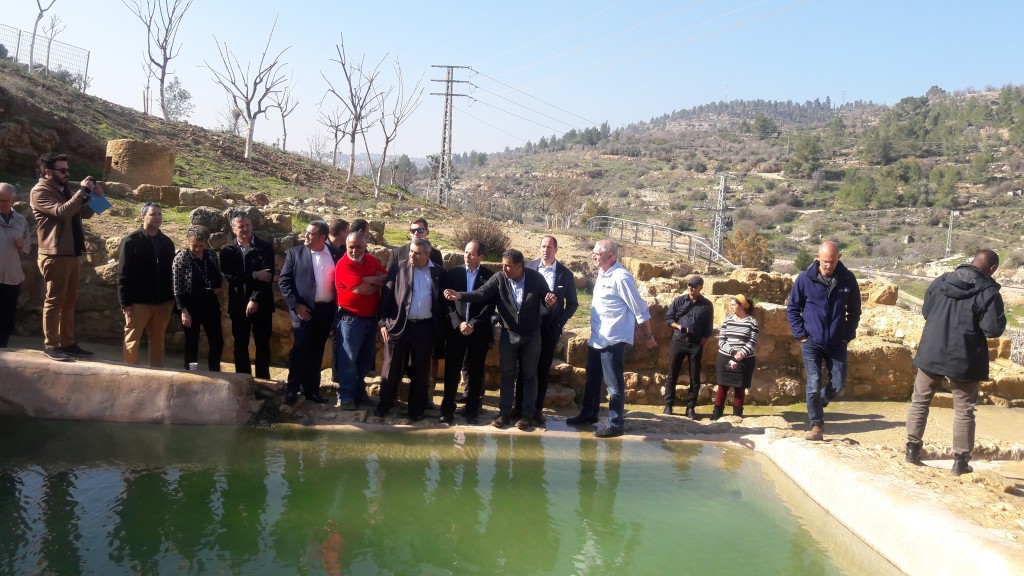
Opening of the Spring of St. Philip in Jerusalem
The Armenian Orthodox Apostolic Patriarchate of Jerusalem – January – February 2018
On Wednesday morning January 31, the official opening of the Fountain of Philip took place. The Jerusalem Development Authority, the Israel Antiquities Authority and the Israel Nature and Parks Authority have renovated the site in close cooperation with the Armenian Apostolic Patriarchate of Jerusalem.
From the side of the Armenian Patriarchate of Jerusalem, His Eminence Archbishop Sevan Gharibian, the Grand Sacristan was present, as well as the Very Reverend Father Samuel, Head of the Financial Department and the Responsible for the Holy Sepulcher, and the Very Reverend Father Koryoun Baghdasarian, Chancellor of the Armenian Patriarchate as well as Dean of the Theological Seminary. A group of his Seminarians sang during the official opening ceremony. The Very Reverend Father Samuel conveyed the speech of His Beatitude Archbishop Nourhan Manougian.
From the Israeli side His Excellency Mr. Ze’ev Elkin, the Minister of Jerusalem, was there at the official opening, as well as the honourable Mr. Nir Barkat, Mayor of Jerusalem, Mr. Yisrael Hasson, the Director-General of the Israel Antiquities Authority Management, Jerusalem District Archaeologist of the Israel Antiquities Authority, Dr. Yuval Baruch, Manager of the Jerusalem Community Council portfolio Mr. Moshe Leon, and other officials and guests, among which a group of youth.
His Excellency Mr. Ze’ev Elkin and the honourable Mr. Nir Barkat planted trees at the site, as is the tradition on yesterday’s Jewish Feast of Tu Bishvat, which was celebrated all over Israel.
In September last year, His Beatitude Archbishop Nourhan Manougian, the Armenian Patriarch of Jerusalem, and the Very Reverend Father Baret Yeghetzian, head of the Real Estate Department of the Armenian Patriarchate, planted olive trees on the alley named after the Armenian Patriarchate. An open altar will be built at the renovated site for the celebration of liturgies.
The Spring
The New Testament, (Book of Acts 8: 26- 39) tells us about St. Philip travelling from Jerusalem in the direction of Gaza. On the way, he encountered an Ethiopian official reading from the book of the Prophet Isaiah. The Ethiopian was in charge of all the treasury of the Queen of Ethiopia and was returning home from Jerusalem. St. Philip explained to the Ethiopian the passage of the prophet and preaches him the Gospel. The Ethiopian then expressed the wish to be baptized, upon which St. Philip baptized him near the road.
It is this Spring which is called after Evangelist St. Phillip, locally the spring is also called Ein Haniya. The Spring is the second largest source of water in the Judean Hills. The spring is 675 meters above sea level and is located in the Rephaim Valley through which the present railroad leads from Jerusalem to Tel Aviv. Already during Roman times this spring had pools (a storage pool as well as a so-called Nymphaeum, water fountains and water pool) as well as a system of aqueducts for irrigation.
Archaeological finds discovered remnants of an Armenian Church, like Armenian inscriptions, a cross and mosaics as well. These are clear proofs that already in ancient times this site was one of pilgrimage, and liturgies were celebrated- as also nowadays liturgies are celebrated at the ancient site of pilgrimage.





798982 761471After study a few of the content material for your site now, i genuinely as if your technique of blogging. I bookmarked it to my bookmark site list and are checking back soon. Pls have a look at my website too and told me should you agree. 231341